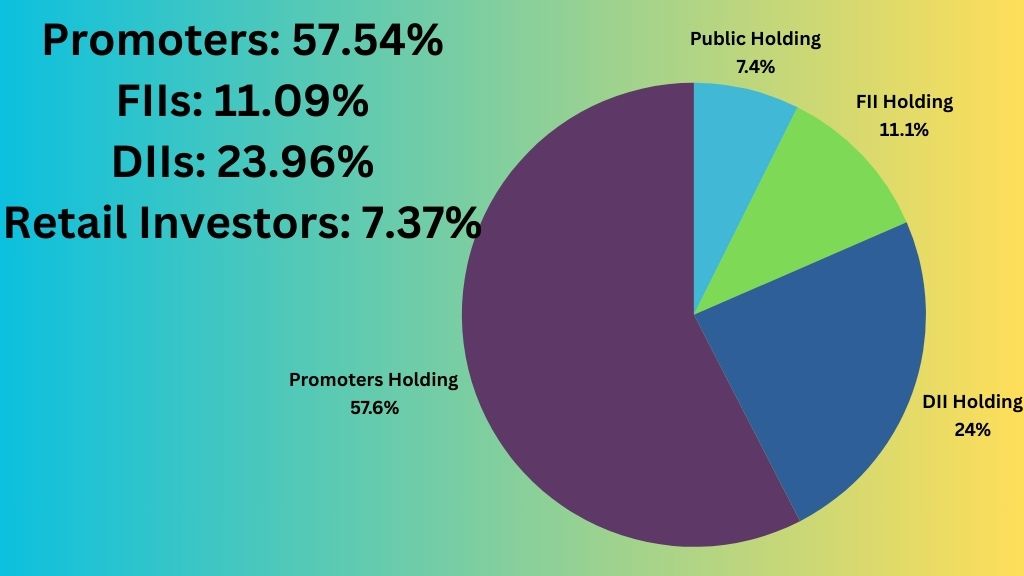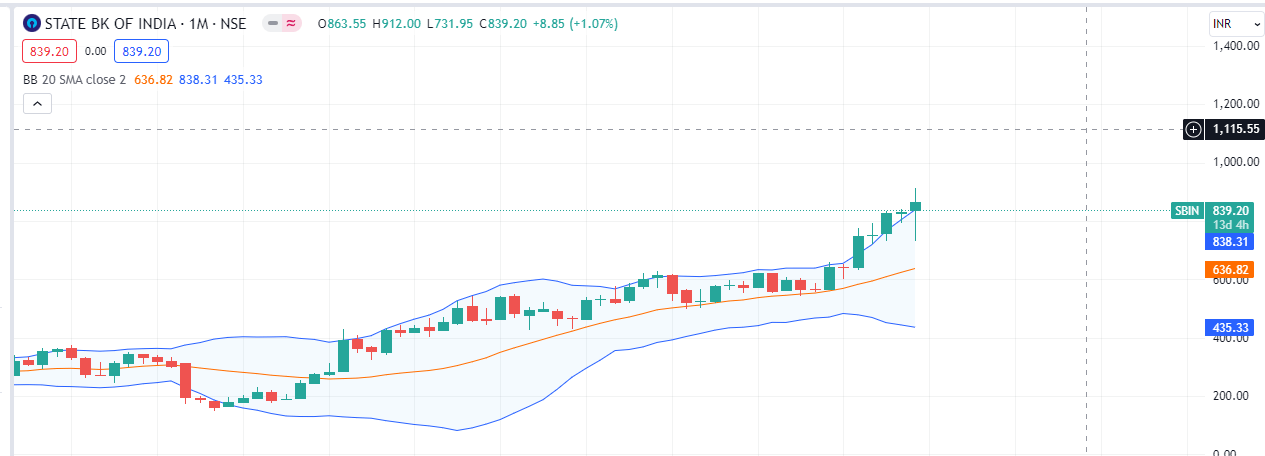If you are looking for a trading share to invest in, then you should consider SBI Share Price Target. In this blog, we will provide you with a basic idea about the SBI Share Price Target from 2024,2025, 2026, 2030, 2040 to 2050. We have done thorough research and taken advice from experts to give you a clear understanding of the company’s growth, performance, and more.
State Bank of India (SBI), India’s largest public sector bank, continues to be a cornerstone of the country’s financial system. Known for its vast network and comprehensive banking services, SBI remains a favorite among investors. This article explores the share price targets for SBI from 2024 to 2050, including fundamental data, shareholding patterns, F&O (Futures and Options) lot size, and more.

Current Performance and Market Trends
As of June 2024, SBI has shown robust financial performance and market presence. The bank’s diverse range of services, from retail banking to corporate banking and treasury operations, drives its growth. Digital banking initiatives and a strong push towards financial inclusion have further strengthened its market position.
SBI Share Price Target Predictions
Below is a table outlining the projected SBI share price targets for from 2024 to 2050:
| Year | SBI Share First Target | SBI Share Second Target |
|---|---|---|
| SBI share price target 2024 | 700.63 | 842.62 |
| SBI share price target 2025 | 855.65 | 895.45 |
| SBI share price target 2026 | 936.15 | 980.34 |
| SBI share price target 2027 | 1020.56 | 1078.45 |
| SBI share price target 2028 | 1125.60 | 1187.45 |
| SBI share price target 2029 | 1245.45 | 1298.12 |
| SBI share price target 2030 | 1363.48 | 1452.54 |
| SBI share price target 2040 | 1945.45 | 2036.16 |
| SBI share price target 2050 | 2,586 | 2,758 |
SBI Fundamental Data and Analysis
| Company Name |
State Bank of India (SBI) |
| Market Cap | ₹ 7,40,698 Cr |
| Primary Exchange | BSE. NSE |
| Face Value | ₹ 1.00 |
| Dividend Yield | 1.65 % |
| TTM PE Ratio | 12.7 |
| PB Ratio | 1.07 |
| Promoter Holding | 57.54% |
| Book Value | ₹465 |
| 52 Week Low | ₹ 543 |
| 52 Week High | ₹ 912 |
Revenue Growth
SBI has consistently reported strong revenue growth. For the fiscal year 2023-24, the bank reported total revenue of INR 91.88K crore, up from INR 83.53K crore in the previous fiscal year. This growth is driven by higher interest income, fee income, and treasury operations.
Profitability
The bank’s profitability remains solid. For the fiscal year 2023-24, SBI reported a net profit of INR 21.38K crore, compared to INR 11.06K crore in the previous year. Effective cost management, lower provisioning for bad loans, and improved asset quality have contributed to maintaining healthy profit margins.
Market Expansion
SBI continues to expand its presence across India and overseas. The bank’s extensive branch network and digital banking initiatives have enhanced its reach. Investments in technology and customer service have further bolstered its market position.
Innovation and Technology
SBI’s investment in technology is a key driver of its growth. The bank has been focusing on digital banking platforms, mobile banking apps, and blockchain technology. These advancements have enabled SBI to offer seamless services and improve customer experience.
SBI Shareholding Pattern
As of March 2024, SBI’s shareholding pattern is as follows:
- Promoters: (Government of India) 57.54%
- Foreign Institutional Investors (FIIs): 11.09%
- Domestic Institutional Investors (DIIs): 23.96%
- Government: 0.03%
- Retail Investors: 7.37%

F&O Lot Size
The current Futures and Options (F&O) lot size for SBI is 3,000 shares. This standardized lot size facilitates trading and ensures liquidity in the derivatives market.
TO Also Read:- RVNL share price target
Detailed Share Price Target Analysis

SBI Share Price Target for 2024
For 2024, analysts predict SBI’s share price will range between INR 700.63 and INR 842.62. This target is based on the bank’s strong financial performance and positive market sentiment. The demand for banking services and digital banking solutions continues to drive growth.
| Year | Target 2024 |
| SBI Share Price First Target 2024 | ₹700.63 |
| SBI Share Price Second Target 2024 | ₹842.62 |
SBI Share Price Target for 2025
In 2025, the share price is expected to rise further, with a projected range of INR 855.65 to INR 895.45. The bank’s strategic initiatives in market expansion and digital transformation will likely contribute to this increase. Improved profitability and robust loan growth will also play a significant role.
| Year | Target 2025 |
| SBI Share Price First Target 2025 | ₹855.65 |
| SBI Share Price Second Target 2025 | ₹895.45 |
SBI Share Price Target for 2026
By 2026, SBI’s share price is forecasted to reach between INR 936.15 and INR 980.34. The bank’s efforts to enhance customer experience through innovative financial products and strategic acquisitions are anticipated to drive growth. Sustained revenue growth and profitability will continue to attract investors.
| Year | Target 2026 |
| SBI Share Price First Target 2026 | ₹936.15 |
| SBI Share Price Second Target 2026 | ₹980.34 |
SBI Share Price Target for 2027
For 2027, analysts expect the share price to be between INR 1020.56 and INR 1078.45. SBI’s strong market position and expanding customer base will support this target. The bank’s focus on technology and customer-centric services will further bolster its market value.
| Year | Target 2027 |
| SBI Share Price First Target 2027 | ₹1020.56 |
| SBI Share Price Second Target 2027 | ₹1078.45 |
SBI Share Price Target for 2028
In 2028, the share price target is predicted to be between INR 1125.60 and INR 1187.45. The bank’s continuous efforts in improving operational efficiency and expanding its service portfolio are key factors. Additionally, strategic partnerships and collaborations will enhance growth prospects.
| Year | Target 2028 |
| SBI Share Price First Target 2028 | ₹1125.60 |
| SBI Share Price Second Target 2028 | ₹1187.45 |
SBI Share Price Target for 2029
For 2029, the share price is projected to range from INR 1245.45 to INR 1298.12. The bank’s robust financial health and strategic initiatives will likely drive this increase. Enhanced digital capabilities and customer loyalty will further contribute to the bank’s growth.
| Year | Target 2029 |
| SBI Share Price First Target 2029 | ₹1245.45 |
| SBI Share Price Second Target 2029 | ₹1298.12 |
SBI Share Price Target 2030
By 2030, analysts expect the share price to reach between INR 1,363.48 and INR 1,452.54. SBI’s consistent performance and innovative approach will attract long-term investors. The bank’s ability to adapt to changing market conditions and client needs will be crucial for this growth.
| Year | Target 2030 |
| SBI Share Price First Target 2030 | ₹1,363.48 |
| SBI Share Price Second Target 2030 | ₹1,452.54 |
Long-Term Projections
SBI Share Price Target for 2040
Looking ahead to 2040, the share price is anticipated to be between INR 1,945.45 and INR 2,036.16. This projection assumes the bank continues to expand its market presence and enhance its service offerings. The bank’s sustained financial performance and strategic growth initiatives will be key drivers.
| Year | Target 2040 |
| SBI Share Price First Target 2040 | ₹1,945.45 |
| SBI Share Price Second Target 2040 | ₹2,036.16 |
SBI Share Price Target for 2050
By 2050, analysts project the share price to range from INR 2,586 to INR 2,758. This long-term target is based on the assumption that SBI will maintain its leadership position in the banking sector. Continuous innovation and market expansion will be essential for achieving this target.
| Year | Target 2050 |
| SBI Share Price First Target 2050 | ₹2,586 |
| SBI Share Price Second Target 2050 | ₹2,758 |
Q&A: Understanding SBI’s Future
Q: What factors drive SBI’s share price growth?
A: Several factors drive SBI’s share price growth, including consistent revenue and profit growth, strong market presence, continuous innovation, and strategic acquisitions.
Q: How does SBI’s focus on digital transformation impact its future?
A: SBI’s focus on digital transformation significantly impacts its future by enhancing customer experience, improving operational efficiency, and attracting tech-savvy clients. This strategic focus positions the bank well for long-term growth.
Q: What are the potential challenges for SBI?
A: Potential challenges include market competition, regulatory changes, and economic fluctuations. Effectively managing these challenges is crucial for maintaining growth and profitability.
Q: How important is market expansion for SBI?
A: Market expansion is vital for SBI. Expanding into new regions and markets allows the bank to grow its customer base, increase revenue, and enhance its market presence.
Q: What role does innovation play in SBI’s growth?
A: Innovation is essential for SBI’s growth. Investment in technology and digital platforms enables the bank to offer cutting-edge financial solutions, stay competitive, and meet evolving customer needs.
Conclusion
SBI’s future appears promising based on its strong financial performance, strategic initiatives, and market expansion efforts. The projected share price targets from 2024 to 2050 provide valuable insights for investors. As always, thorough research and analysis are recommended before making investment decisions. Investors should consider market conditions, individual risk profiles, and long-term growth prospects when evaluating SBI as an investment opportunity.
